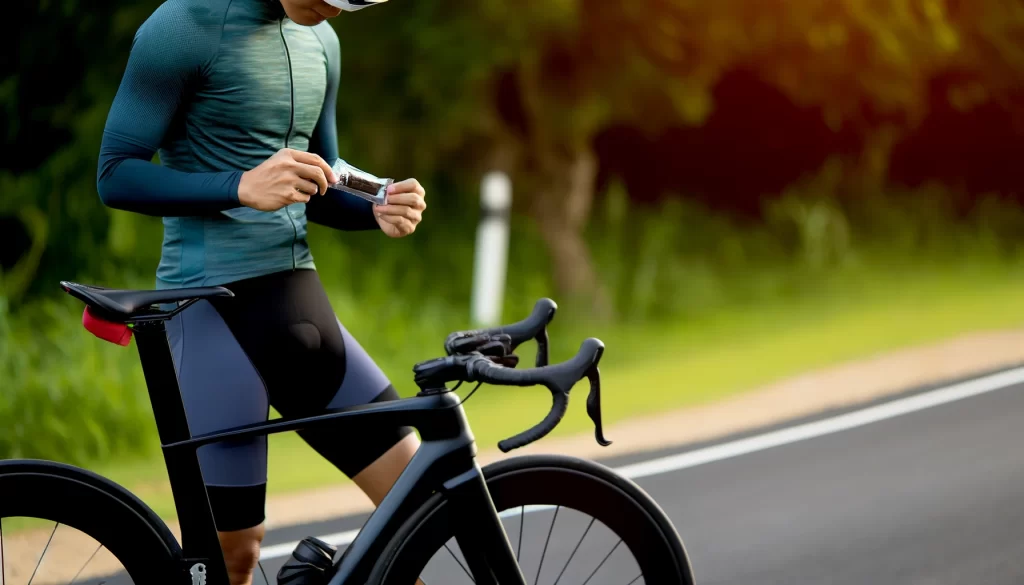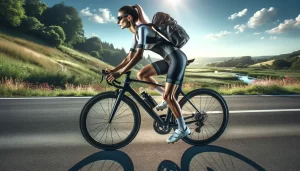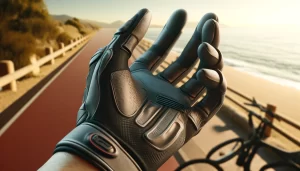Bars for cyclists are more than just a snack; they are an essential component of a cyclist’s gear, much like a good pair of pedals or a reliable helmet. These compact powerhouses are designed to deliver a swift boost of energy that is crucial during long rides or intense races.
Packed with a blend of carbohydrates, proteins, and sometimes fats, energy bars are specifically formulated to meet the high-energy demands of cycling, ensuring that every pedal stroke is as powerful as the first.
The importance of choosing the right energy bar cannot be overstated. With a variety of options on the market, each claiming to be the perfect solution for your cycling needs, it can be overwhelming to select the one that truly complements your body’s requirements and cycling style.
This guide aims to demystify the world of energy bars for cyclists, providing you with the insights you need to make informed choices that enhance your performance without compromising your health. Stick with us as we delve into how to select, use, and maximize the benefits of energy bars to keep your wheels spinning efficiently mile after mile.

Image Source: Image Generated With DALL-E on ChatGPT
Benefits of Energy Bars for Cyclists
Energy bars are compact and nutrient-dense snacks designed to provide a quick energy boost for cyclists. They are particularly useful for endurance riding and races, supplying a mix of carbohydrates, proteins, and fats that are crucial for sustained performance.
These bars are convenient to consume even while pedaling and help in maintaining glycogen levels, preventing fatigue. Additionally, they often contain a blend of vitamins and minerals that aid in muscle recovery and hydration.
Tips for Using Energy Bars for Cycling:
- Pre-Ride Boost: Eat an energy bar 30-60 minutes before riding to top up your energy reserves.
- Mid-Ride Fuel: Consume half a bar every hour during long rides to maintain energy levels.
- Post-Ride Recovery: Have a bar with higher protein content after cycling to aid muscle recovery.
- Hydration: Pair your energy bar with adequate water to aid digestion and nutrient absorption.
- Variety: Rotate between different flavors and brands to avoid flavor fatigue and balance nutrient intake.
How to Choose the Right Energy Bar for Cycling
Selecting the right energy bar for cycling depends on your specific nutritional needs and taste preferences. Factors to consider include the balance of nutrients, the type of ingredients used, and the overall calorie content.
A good cycling energy bar should have a high carbohydrate content for energy, moderate protein for muscle repair, and be low in fat for easy digestion.
Steps to Choose the Right Energy Bar for Cycling:
- Check Nutrient Balance: Look for a carbohydrate to protein ratio of about 3:1 for optimal energy and recovery.
- Read Ingredients: Opt for bars with natural, whole-food ingredients for better nutrient quality and easier digestion.
- Consider Intensity and Duration: For longer or more intense rides, choose bars with more carbohydrates and electrolytes.
- Taste Test: Try different flavors to find ones that you enjoy and can eat regularly without palate fatigue.
- Dietary Restrictions: Look for bars that fit any dietary restrictions you may have, such as gluten-free or vegan options.
Impact of Energy Bars on Cycling Performance
Energy bars can significantly impact cycling performance by providing a quick, convenient source of energy. These bars are formulated to be digested quickly, releasing energy without causing gastrointestinal distress.
They are particularly effective during long-distance rides or races where maintaining a steady supply of carbohydrates is crucial for endurance. By preventing blood sugar levels from dropping, energy bars help sustain a cyclist’s performance and delay the onset of fatigue. Moreover, some bars contain caffeine and other enhancers that can temporarily boost focus and intensity.
Tips for Maximizing Cycling Performance with Energy Bars:
- Timely Consumption: Eat energy bars before you feel depleted to maintain optimal energy levels.
- Balance Intake: Combine energy bars with other nutritional sources like energy gels and real foods for balanced energy.
- Monitor Effects: Pay attention to how different bars affect your performance and stomach comfort during rides.
- Training Integration: Use energy bars during training rides to simulate race conditions and test their effectiveness.
- Recovery Aid: Select energy bars with higher protein content post-ride to support muscle recovery.
How to Integrate Energy Bars into a Cycling Training Plan
Integrating energy bars into a cycling training plan can help manage energy levels and recovery throughout different phases of training. Whether you are building endurance, speed, or recovering, energy bars can be tailored to meet the varying nutritional demands of these activities.
Steps to Integrate Energy Bars into a Cycling Training Plan:
- Pre-Training: Consume an energy bar 30-60 minutes before training to ensure your energy stores are full.
- During Long Rides: Use energy bars as part of your on-bike nutrition strategy to sustain energy over hours.
- High-Intensity Sessions: Choose energy bars with quick-releasing carbs for short, intense efforts to boost performance.
- Recovery: Post-workout, opt for bars that have a blend of carbs and proteins to facilitate muscle repair.
- Regular Assessment: Evaluate how well the bars are meeting your energy needs and adjust types and timing as necessary.
- Training Variety: Incorporate different types and flavors of bars to prevent monotony and adjust to changing nutritional needs as your training intensifies or tapers.
Energy Bars and Hydration During Long Rides
Energy bars play a vital role in sustaining a cyclist’s performance during long rides, but they must be complemented with proper hydration to be effective. As cyclists exert themselves, they not only burn through calories but also lose significant amounts of water and electrolytes through sweat.
Energy bars, typically rich in carbohydrates, help replenish the energy stores that are depleted over long distances. However, without adequate hydration, the effectiveness of these bars decreases significantly, as dehydration can lead to a reduction in physical performance and cognitive function, making it difficult to maintain pace and focus over extended periods.
To optimize the benefits of energy bars during long rides, cyclists should also focus on maintaining electrolyte balance. This can be achieved by consuming sports drinks or water with added electrolytes, which help in retaining fluids and preventing hyponatremia (low blood sodium levels).
The combination of solid nutrition from energy bars and fluid intake helps maintain blood glucose levels and supports muscle function, which is crucial during endurance activities. Therefore, integrating a hydration strategy with the consumption of energy bars is essential for effective fueling during long-distance cycling.

Image Source: Image Generated With DALL-E on ChatGPT
Energy Bar Consumption Strategies in Cycling Competitions
In competitive cycling, the strategic consumption of energy bars can be the difference between maintaining optimal performance and experiencing an energy dip at crucial moments. During races, cyclists need a quick, reliable source of energy that doesn’t divert blood away from the muscles to the digestive system, which can occur with heavier, richer foods.
Energy bars are designed to provide a rapid release of energy without being too heavy, making them ideal for consumption even at high intensities. The key is to consume these bars before energy levels drop too low; hence, timing becomes critical. Cyclists often plan their intake based on the race profile—consuming energy bars just before a climb or during a less intense segment to ensure they have the necessary energy to push through more demanding parts.
Furthermore, the type of energy bar is also an important consideration during competitions. Bars with different compositions (e.g., higher sugar content for quick energy vs. more complex carbohydrates for sustained release) can be used strategically depending on the race demands and individual energy metabolism.
Cyclists might start with bars that have a balance of nutrients and then switch to more rapidly digestible options as the race progresses and the body begins to fatigue. This strategy ensures that the energy supply is matched with the physical demands of the race, allowing cyclists to optimize their performance and endurance effectively.
Frequently Asked Questions About Energy Bars for Cyclists
1. When is the best time to eat an energy bar while cycling?
It’s optimal to consume an energy bar before you start feeling depleted. During long rides, eating a small portion every hour helps maintain energy levels. After a ride, an energy bar can aid in recovery, especially those formulated with a higher protein content.
2. Are energy bars suitable for all types of cycling?
Yes, energy bars can be beneficial for all types of cycling, from casual rides to competitive racing. However, the type and quantity might vary depending on the intensity and duration of the cycling activity.
3. Can energy bars replace meals for cyclists?
While energy bars are a convenient source of nutrients, they are not intended to replace meals. They are best used as a supplement to a balanced diet, particularly during long rides or races where traditional meal consumption might be impractical.
4. How do I choose the right energy bar for my cycling needs?
Look for energy bars that match your nutritional requirements, such as carbohydrate content for quick energy or protein for recovery. Consider any dietary restrictions like gluten-free or vegan preferences and choose bars with natural, whole-food ingredients for better digestibility.
5. Can energy bars cause digestive issues during cycling?
Some cyclists might experience digestive discomfort from certain energy bars, especially those high in fiber or sugar alcohols. It’s important to test different bars during training sessions to choose one that suits your digestive system.
Energy bars are an integral part of a cyclist’s nutrition strategy, offering a compact and efficient way to manage energy and recovery needs during rides.
They are especially useful in maintaining performance over extended periods and can help cyclists meet their dietary needs without having to stop for a meal. When chosen carefully and used strategically, energy bars can significantly enhance a cyclist’s endurance and overall performance.
In conclusion, while energy bars are a beneficial tool for cyclists, they should be incorporated thoughtfully into a broader dietary and hydration plan tailored to individual needs and the specifics of the cycling activity. By understanding when and how to effectively use these bars, cyclists can optimize their energy levels and focus on enjoying the ride or competing at their best.
Did you like the article? Be sure to check out more content like this in the Equipment And Accessories category, or see more related content below.






